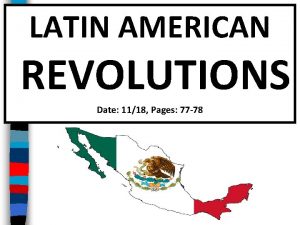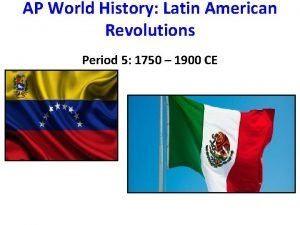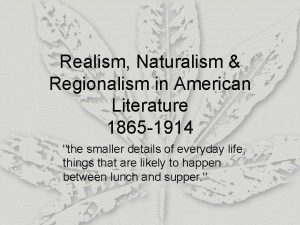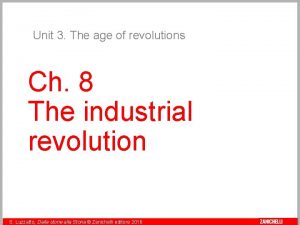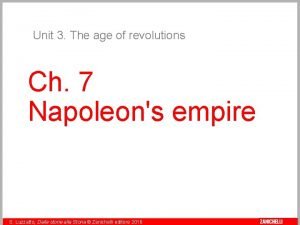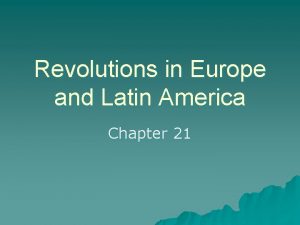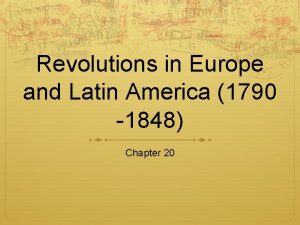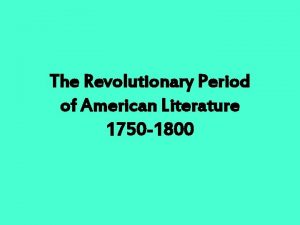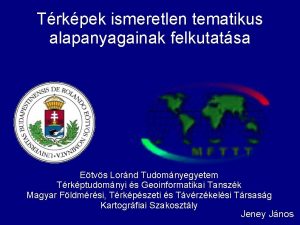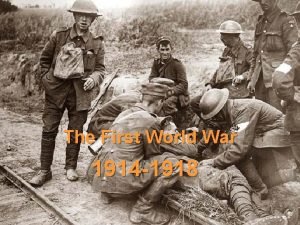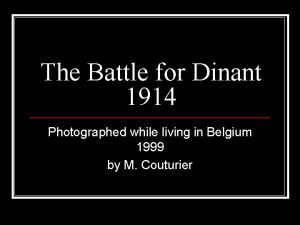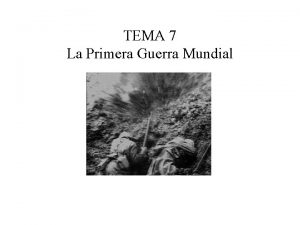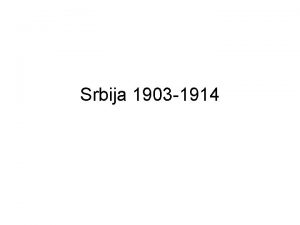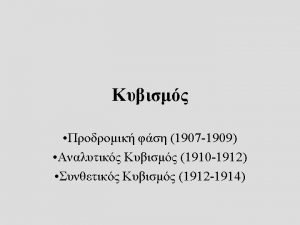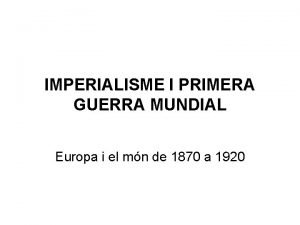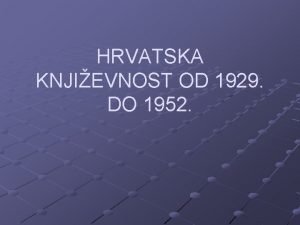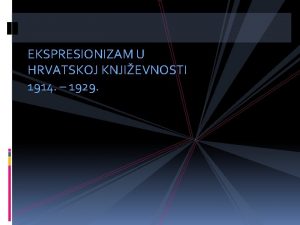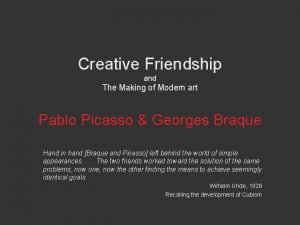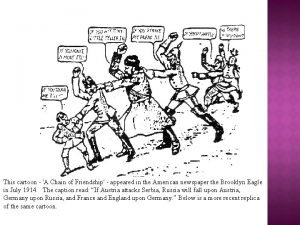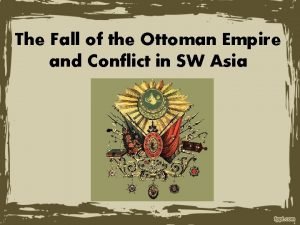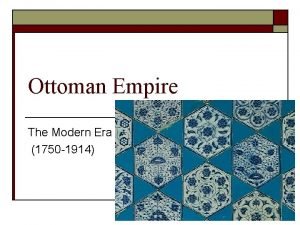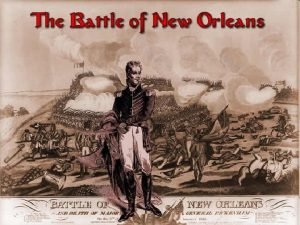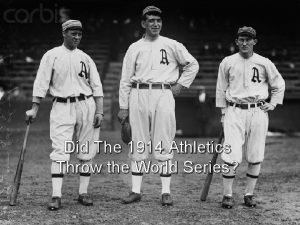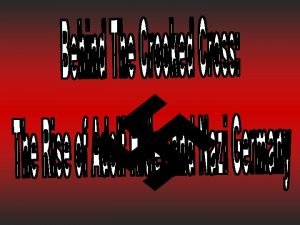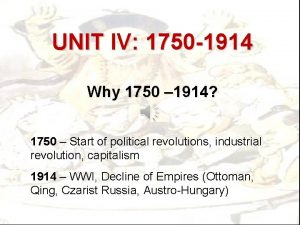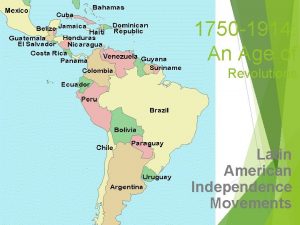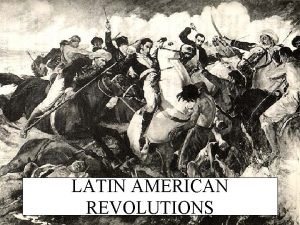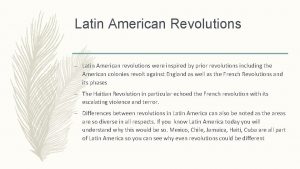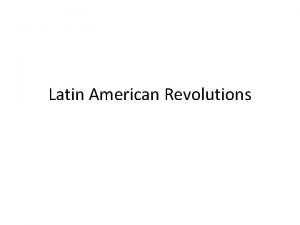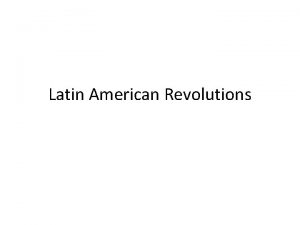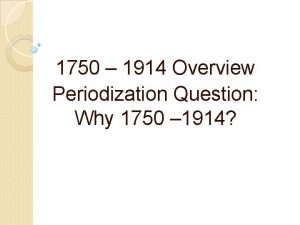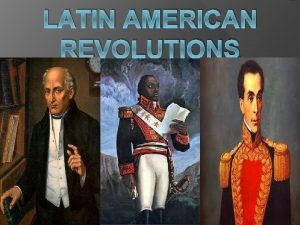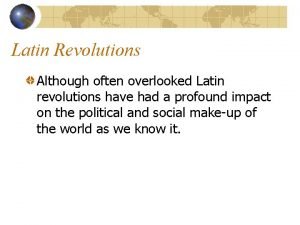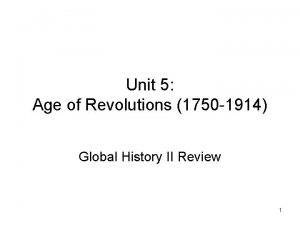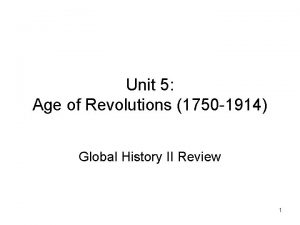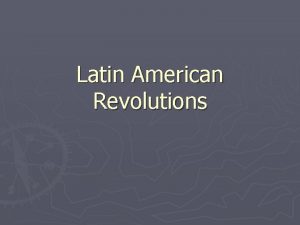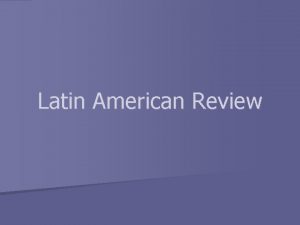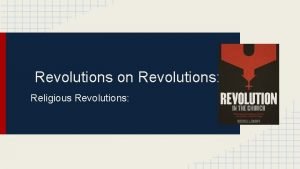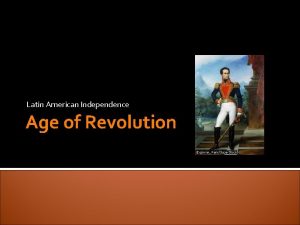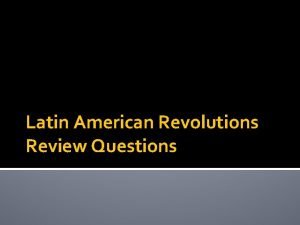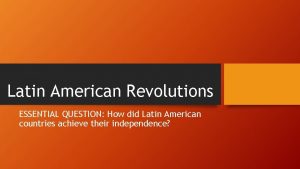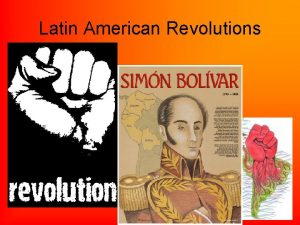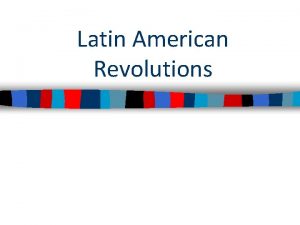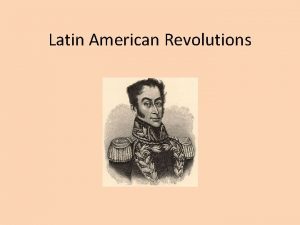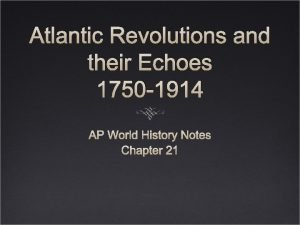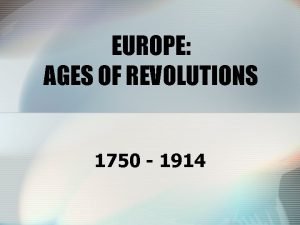1750 1914 An Age of Revolutions Latin American






























- Slides: 30

1750 -1914: An Age of Revolutions Latin American Independence Movements

Background • Indigenous peoples and civilizations – Maya, Aztec, Inca • European Colonization, 1500 s – Spain, Portugal, France • American Revolution, 1776 • French Revolution and Enlightenment, 1789 • Napoleon’s conquests within Europe, 1800 s

Latin American Independence Movements, 18 th & 19 th C.

Results • Caudillos – Strong military leaders emerge – Dictatorship and totalitarian systems emerge • Dependency theory challenges “Moderninity” theory – Western European markets determine the product – South America dependent upon others buying their one crop • Banana Republics – United Fruit Company controlled Central America in late 19 th and early 20 th century – Phrase coined to designate politically unstable, dependent on limited agriculture, and ruled by a small, wealthy and corrupt clique put in power by the United States government in conjunction with the CIA and the US business lobby

French colonies: Revolution in Haiti • Saint Domingue, now known as Haiti • Western third of island of Hispanola in Caribbean Sea. • Plantation slavery, sugar

Toussaint L’Ouverture • Former slave, self-educated. • Untrained in military and political matters, but became a skilled general and diplomat. • Allegedly got name (“opening” in French) from being able to find openings in enemy lines. • Took leadership of a slave revolt that broke out in 1791. • 100, 000 slaves in revolt.

• By 1801, L’Ouverture moved into Spanish Santo Domingo (the eastern two-thirds of the island of Hispanola), took control of territory and freed slaves. • In January 1802, French troops landed. • Toussaint agreed to an end of fighting if the French would end slavery • French accused him of planning another uprising. • Sent him to a prison in the French Alps. • He died 10 months later, April 1803.

Jean-Jacques Dessalines • • Toussaint’s general. Took up the fight. Jan 1, 1804 - declared an independent country. First black colony to free itself from European control. • He called it Haiti, “mountainous land, ” in the language of the native Arawak inhabitants. • Became first emperor of Haiti; later assassinated in a revolt. • 1820: Haiti became an independent republic

Spanish Colonies Revolutions against Spanish Rule

Latin American social classes • Peninsulares - men born in Spain – held highest offices • Creoles - Spaniards born in Latin America – officers in army, but not in government – often resented power of the peninsulares • Mestizos - mixed European and Indian • Mulattos - mixed European and African • Indians

European Background: Napoleon • Napoleon invaded Spain in 1808. • Removed Spain’s King Ferdinand VII and made Joseph (Napoleon’s brother) king of Spain. • Creoles used it as a reason for revolution. • 1810 rebellion across Latin America. • 1814, Napoleon defeated and Ferdinand returned to power, but creoles continued their movement.

Simon Bolivar • Wealthy Venezuelan creole. • “The Liberator”

Venezuelan Independence, 1821 • Venezuela declared independence, 1811. • Bolivar’s armies unsuccessful at first. • 1819: Bolivar marched armies over Andes into today’s Colombia, defeated Spanish army. • 1821: Venezuelan independence. • Marched north to Ecuador to meet Jose de San Martin.

Jose de San Martin • Simple, modest man. • Born in Argentina, spent time in Spain as military officer.

Argentinean Independence • Argentina declared independence in 1816. • San Martin led army across Andes to Chile, joined by Bernardo O’Higgins, and freed Chile. • Ecuador, 1822: San Martin met with Bolivar to decide how to remove remaining Spanish forces in Lima, Peru.

• San Martin sailed for Europe and died on French soil in 1850. • Dec 9, 1824, Bolivar defeated Spanish at Battle of Ayacucho.

Bolivar San Martin

Gran Colombia, 1820 -1830 Bolivar’s vision of a united South America Present-day Colombia, Ecuador, Venezuela and Panama. Short-lived due to dissension amongst various factions. Bolivar resigned in 1828. In 1830, Bolivar’s Gran Colombia divided into Colombia, Ecuador and Venezuela. Panama later split from Colombia with US assistance, 1903.

Mexico • Indians and mestizos, not creoles, played the key role in independence movements. • Creoles sided with Spain to avoid violence of lower-class rebellions (until 1820).

Miguel Hidalgo • A village priest, believed in Enlightenment ideals. • 1810, called for revolution. – Grito de Dolores • Hidalgo’s Indian and mestizo followers marched to Mexico City. • Spanish army and creoles acted against Hidalgo and defeated him in 1811.

Jose Maria Morelos • Took leadership after Hidalgo’s defeat. • Defeated by creoles.

Mexican Independence, 1821 • 1820 revolution in Spain put a liberal government in power. • Mexican creoles feared loss of influence, so they united against Spain. • Agustin Iturbide declared himself emperor, but was overthrown. • 1824: Establishment of the Mexican Republic.

Portuguese Rule • Treaty of Tordesillas of 1494 divided the Atlantic between Spain and Portugal. • Portugal was mostly focused on routes to Asia in the 15 th and 16 th centuries.

Brazilian Independence • In 1807, Napoleon marched on Iberian peninsula, forcing Portuguese royal family of King John VI to escape to Brazil, Portugal’s largest colony. • From 1807 to 1815, Brazil was center of Portuguese empire.

• With defeat of Napoleon in 1815, Portugal wanted Brazil to become a colony again. • By 1822, creoles demanding independence signed a petition asking Portugal’s prince, Dom Pedro, to rule Brazil. • On Sept 7, 1822, Dom Pedro agreed, and declared Brazil’s independence • Emperor Pedro I, to emulate Napoleon and to unify various elements of Brazil. • Pedro’s political and personal problems led to a decline in his popularity. • 1889, Brazilians overthrew Pedro’s successor and declared their country a republic.

United Provinces of Central America • Several other Central American states declared their independence from both Spain and Mexico to create the United Provinces of Central America.

• By 1841, United Provinces of Central America had split into republics of El Salvador, Nicaragua, Costa Rica, Guatemala and Honduras. • Conservative clergy and wealthy landowners resisted liberal, democratic reforms. • Inability to agree to terms of a canal cost it much-needed revenue.

Late 19 th century Trends: Strongman Rule, Liberalism, commercial development • Dictators in Venezuela, Mexico, Colombia – Caudillo = strongman leader – Relied on force – outlawed opposition, regulated schools and newspapers – used jails, police and firing squads – often corrupt – sometimes supported liberal policies • Liberal governments return to power – Even strongmen often supported “liberal” policies • regular elections, but with restricted voting rights (oligarchic democracies)

Results of Latin American Independence Movements • Political/Social: – Continued battles between liberals, conservatives and the military over how to best rule. – Tensions between articulate political forces and the separate masses. • Economic: – Unable to free itself from dependence on Westerncontrolled economic patterns. • Cultural/intelligent: – Distinct cultural entity • combination of Western styles and values plus its racial diversity, colonial past, and social structure of a semicolonial economy.

 Latin american revolutions date
Latin american revolutions date Monroe doctrine definition ap world history
Monroe doctrine definition ap world history Stone age chronology
Stone age chronology Iron age bronze age stone age timeline
Iron age bronze age stone age timeline Regionalism literature
Regionalism literature Zanichelli
Zanichelli An age of revolutions zanichelli
An age of revolutions zanichelli Revolutions in europe and latin america section 1 quiz
Revolutions in europe and latin america section 1 quiz Revolutions in europe and latin america
Revolutions in europe and latin america Revolutionary period literature
Revolutionary period literature In 1914, who controlled the shaded areas on the map?
In 1914, who controlled the shaded areas on the map? Európa térképe 1914-ben
Európa térképe 1914-ben Colonial empires 1914
Colonial empires 1914 Battle of dinant
Battle of dinant Imperialism map 1914
Imperialism map 1914 Conclusiones de la segunda guerra mundial
Conclusiones de la segunda guerra mundial Topovsko pitanje
Topovsko pitanje Ma jolie
Ma jolie Causes del colonialisme
Causes del colonialisme Drugo razdoblje u hrvatskoj književnosti
Drugo razdoblje u hrvatskoj književnosti Hrvatski ekspresionizam predstavnici
Hrvatski ekspresionizam predstavnici Picasso ma jolie 1914
Picasso ma jolie 1914 Colonial empires 1914
Colonial empires 1914 Chain of friendship cartoon analysis
Chain of friendship cartoon analysis How did the ottoman empire fall
How did the ottoman empire fall Ottoman empire 1914
Ottoman empire 1914 Moda 1914
Moda 1914 Squirrel guns 1814
Squirrel guns 1814 Braves
Braves 1914 1918
1914 1918 Nazi party
Nazi party
